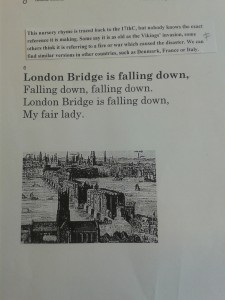The other day in class “Exploring children’s literature in English” we were working on Nursery Rhymes. An example for those who do not be sure about what a Nursery Rhyme is, I am going to put one that I know you sure know:
“Sal Solecito”
Sal solecito
caliéntame un poquito.
Por hoy, por mañana,
por toda la semana.
Perhaps now you will have a smile on your face and you stand remembering all the rhymes or “cancioncillas” you learned when you were a child.
Learning these rhymes may seem silly (Which use the have given except sing occasionally?) Also many of them have no a specific meaning neither a clearly text, but I can say that actually they can be a good memoristic and linguistic resource for students while having fun.
The first thing we did in this session was to work on a dictate where we learned the history of this kind of literature:
Nursery rhymes (or mother goose) were created during the 14th century. They were created to express traditions, political ideas, social critiques or historical events. They were passed by word of mouth. But, after many centuries they have lost the original meaning and have remained (has we know them) the typical innocent children songs-chants.
Nowadays, there are a lot of popular nursery rhymes created, specially, for education. We can find four types of Nursery rhymes: Lullabies, Counting & Alphabet, Riddles; and Historical rhymes events & Culture.
Then we had to try to see what could be the original meaning of various Nursery Rhymes:
And finally we prepare one class and represent in front of our peers.
But, Are they really so important for our classroom. Are they useful for our students?
After this session I can say yes with confidence. Nursery rhymes not only serve to improve the memory capacity of our students, not only to work phonetics may appear in them; it is much more.
While we work these aspects we are also working some multiple intelligences of our students such as Kinesthetic (they do body movement, with the used of gestures or movements in the representations, what makes students learn to express themselves with their body and lose the embarrassment of public speaking), Musical (all of them have a rhythm) or Linguistic (they are basically text).
In conclusion, I believe that this type of text helps students in all aspects that I mentioned before and that make them a good kind of text to work in class because working with a texts do not only mean you have to read it, you can also think about the actions that you read, represent them with your friends and also sing it!

